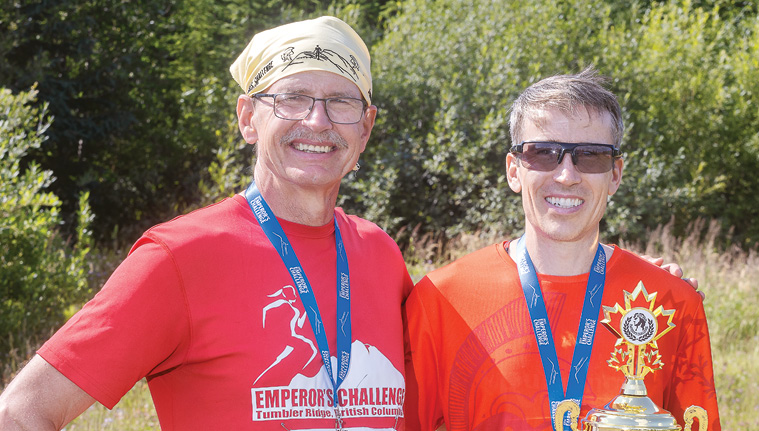Hundreds of people have run the Emperor’s Challenge more than five times.
And dozens of people have done it ten times.
But only two have done the race every single year. Charles Helm and Kris Swanson.
Charles says its weird to be one of the only two to be left standing (or rather, running). “I would never have dreamed in the beginning when we did the first preliminary run just to check out if the route was feasible,” says Helm. “At that stage the town’s future was very uncertain. The coal mines were closing and the Emperor’s Challenge was one thing our group of volunteers could do to try and create something that would bring people into Tumbler Ridge and portray the community in a positive light. And that was really all we were thinking at the time. We would never have thought that 24 years later we’d still be going strong.”
He says back in the beginning, there were a lot fewer people to run the race. “The fields were fairly small,” he says. “We were all finding our feet as it were on the old course on Mount Roman, which was a very tough course. And over the years the course has changed quite a bit, because we had to accommodate mining changes at Peace River Coal. So initially we ran in a counterclockwise direction, then mining operations began and Nigel Mathews, who had been one of the instigators of the entire concept of the race, he came up with the route up a gully on Mount Roman which we called the Mathews Gully. And I think we ran that for two or three years which was a remarkable route going up the steep gully. And we’ve got some amazing photographs of that with just these dozens and dozens or maybe even hundreds of runners struggling to make their way up this rocky gully.
“And then the route changed again because the mining operations increased and there was no way we could do Mount Roman. So my son Daniel and I did a recce on Mount Babcock and said ‘wow we can do a 20-21k run on Mount Babcock which has arguably even better scenery than we ever had on Mount Roman.’ So we reported back to the committee, we have an alternative route, it’s a go, and we’ve now held more races on Babcock than we ever did on Roman.”
When the race turned 20, there were four runners who had run it every year, but when the race came back after Covid, two of those people didn’t return. (One—Birgit Sharman—got Covid and was unable to run the race, though she did the route a couple days later once she had recovered.)
And, while there’s now been 24 Emperor’s Challenges, neither Helm nor Swanson has any desire to stop. (Indeed Swanson just set a new course record for the new route.)
The two proudly wear their five-year bibs to every race. “Kris, of course, has the number one bib because he was the first finisher,” says Helm. “Rudy Heistad finished second, and had also done five years, and I came in third, so I’ve got my permanent number three. That is something I wear with great pride every Emperor’s Challenge.”
(Heistad was still running the race in 2017, but he, too, is no longer showing up.)
The Emperor’s Challenge of 2024 is a much different race than it was when it started, and Helm and Swanson are both different people. At the time, Swanson had no idea what he was doing. “I was just young and naive enough to get away with it,” he says. “When you run half an hour for a training run, and then you just jump into a five hour, five mountain adventure run, you don’t even think twice about it. You don’t bring the right food. You don’t prep properly for it. You haven’t trained for it, but because I was 18 years old, I could just … do it. You just do it. It was the right time of my life for that. And it was great.”
Swanson says his goal was actually to go farther in track and field, but suffered injuries that prevented him from pursuing that. “It was an easy transition [to mountain running] because Tumbler Ridge was always in my rotation. I was always more of a trail runner, cross country runner. So once I started struggling on the road with injuries, it was the obvious transition. I could get into something that didn’t get me injured and I was good at it. And I had no obligations to universities anymore. So I got more into mountain running that way. But even then, it wasn’t a straight line. I actually miss track quite a bit.”
Does he have a favourite moment after 24 years? No, he says. “I don’t like favorite moments because they diminish all the other great moments.”
That said, he is quite fond of all the celebrations that happened when the race turned twenty.
But while he refuses to pick a favourite moment, he says every race has high moments and low moments. But one that stands out is the 2007 race. “I blew my quads out on the downhill. That was a low moment because I lost all my ability to be competitive. My legs were shot, and that’s the year that I lost. You’re extremely vulnerable when things like that happens, and that never feels good, but it was also a great race. So it was also one of the best years because it was really intense. That was a low moment in an intense year, in a wonderful intense year.
“Any time where I feel a bit more vulnerable is a low moment, and that happens a bit more with age. I just don’t feel like I have top gears anymore. That’s happening a lot more frequently. But at the same time, those are also high moments because I’m still running strong as a middle-aged runner. I’m still being able to be competitive. So it just ebbs and flows between the two. You run up a hill really well, and you’re feeling good about your progress, and then all of a sudden, then you just hit a slump and you feel vulnerable, and there’s a low moment.”
Getting older is something that Helm knows all too well. He’s now 66 years old. “When you reach 66, you’re just grateful that you can still do it,” he says. “You’re not worried about your time you’re not worried about anything just the fact that you can be out there and experience the magic of the day and share this great race with so many other runners and walkers. I can slow down to walking pace if I like and try and sneak in under the five-hour barrier, which is still an hour and a half or so away for me. One hopes one doesn’t get sick or suffer an injury or something like that, but there’s no plan to stop.”
As a local doctor, Helm says his lowest, or at least most terrifying moment was the year someone fell in the tundra and sustained a fracture in his neck. “It wasn’t a major fracture, but he had to be brought out on a stretcher so that’s terrifying. I’ve been telling committee members for a long time at some point in races like this someone drops down dead and it’s not gonna be our fault but it just happens and almost every other major mountain race has had that happen. We’ve been very lucky and I hope that luck continues.
“On another occasion someone fell down and broke her nose and was struggling to breathe because of this nasal fracture. As it happened, our respiratory physician from Prince George was a few metres behind her and essentially gave up her race to be with this person for the next hour or two. If you’re going to fall on Mount Babcock and break your nose, you want a respirologist to be right behind you.”
Helm says one of his favourite moments on the original route was a section called the Twisting of the Knife. “You’d run over Mount Roman, the you’d run down. The lowest point elevation wise of the race was with about 400 meters to go because you cross the bridge across Babcock Creek and then you’d have to climb uphill. Instead of running around the hill and the nice flat finish we had people climb up this rock cutting. We carved a few steps into this, so people could climb up this 20 foot high wall. Then it was a quick 50 metre sprint to the finish. That just killed people and it was awesome. it was wonderful to watch, if you were a sadist. Many people just cramped up and couldn’t run, so they hobbled to the finish line. If you had a macabre sense of humor it was very funny but enough people complained about it that we had to change it. My wife Linda was one of them. She would just hobble in every year and be in a really bad mood.”
Other high points for Helm? Was the year of the Fancy Dress Competition. “Racers were invited to dress up. I ran as a slave and Fred Walkley ran in a wonderful centurion outfit. He had a staff and helmet and everything and I didn’t stand a chance. I just had a loincloth on and nothing else. The night before I got an adult diaper from the emergency room because I thought I’d run in that. I ran about 10 metres in it and I can just tell you that Depends are not made for running.”
In his time doing the race, Helm has been stung multiple times by yellow jackets. “I have a yellow jacket allergies, so I have to slow down, because you don’t want to be racing like crazy when you’ve been stung by wasps. But then you’ve got a really good excuse why your times a bit slower too because you could stung by yellow jackets.
While there have been many things to come and go over the last 24 years—from the costumes to the walking race to different routes—Helm says the thing he misses most are the caribou. “We used to see caribou almost every time. It was very gratifying. There was a herd of caribou seen on the Terminator just recently, but it’s a long time since I’ve seen any caribou out there and that’s been sad. These days, we see lots of goats. Sometimes we run past 40 or 50 goats right up there near the summit of Babcock which is always a very special.”
Swanson doesn’t race as much as he used to, but the Emperor’s Challenge is non-negotiable. “I’m not running as much anymore,” he says. “But I often think to myself, well, I gotta make sure that whatever I do, I can always have vacation time to go to Tumble Ridge. And it’s become a part of my life.”
But it’s not just the race. It’s home. “It’s Tumble Ridge. You asked earlier about my low points. I’d say the lowest points were the two years we had to miss. Especially the one year that I skipped and didn’t even make it to Tumble Ridge. The Emperor’s Challenge definitely gets me there. And that has value in itself outside of the race. When I run with people in the mountains around Victoria, they get a sense of serenity that I don’t, because I grew up running in Tumble Ridge. They feel like they’re deep in the wilderness, but I’m aware that I’m only 20 km from a city. I grew up in Tumbler, where there’s literally nothing but mountains around you. I have to get my dose of that by going back.”

Trent is the publisher of Tumbler RidgeLines.

